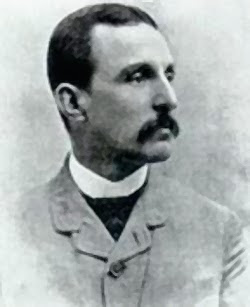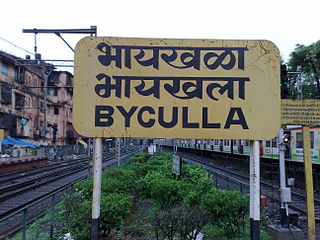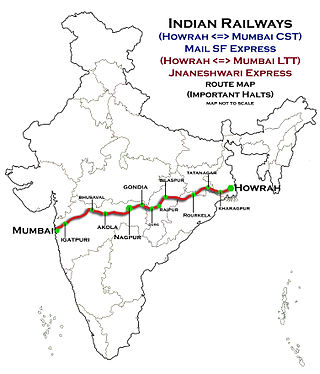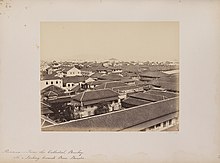
Thane is a metropolitan city located on the northwestern side of the state of Maharashtra in India. It is an immediate neighbour of Mumbai city proper, and a part of the Mumbai Metropolitan Region. It is situated in the north-eastern portion of the Salsette Island.

Chhatrapati Shivaji Terminus (officially Chhatrapati Shivaji Maharaj Terminus since 2017, formerly Victoria Terminus (VT), Bombay station code: CSMT (mainline)/ST (suburban)), is a historic railway terminus and UNESCO World Heritage Site in Mumbai, Maharashtra, India.
Bhandup is a suburban locality in Mumbai, in the state of Maharashtra, India. The name Bhandup is derived from Bhandupeshwar, one of the names of the Hindu god Shiva. An old temple dedicated to Lord Shiva, the Bhandupeshwar Mahadev Mandir, is located in Bhandup (west) near Moti Bai Wadi IDUBS high school. Sonapur signal is north lead line on L.B.S. Marg and south is dockyard colony. Bhandup railway station is on the Central line of the Mumbai Suburban Railway network. A few fast trains stop at Bhandup station, mostly during the peak hours.
Trams in India were established in the late 19th century. Horse-drawn trams were introduced in Kolkata in 1873; in Mumbai, trams began operations in 1874; in Nashik in 1889; electric trams began in Chennai in 1895, and trams were also introduced in Kanpur and Delhi. They were discontinued in all Indian cities between 1933 and 1964, except for Kolkata.

Masjid is a railway station in the Masjid Bunder area of South Mumbai on the Central and Harbour lines of the Mumbai Suburban Railway. It is the penultimate stop for all trains on those lines in the "up" direction. It was opened in 1877. The station is named after a masjid (mosque) annexed to this Suburban Railway Station. That is SAT TAD Masjid. Contrary to popular belief a synagogue, is never called a masjid. This Railway station is in Mandvi Section.

Frederick William Stevens was an English architectural engineer who worked for the British colonial government in India. Stevens' most notable design was the railway station Victoria Terminus in Bombay.

Kandivali formerly Khandolee is a suburb in the north of Mumbai, Maharashtra, India and has a large Gujarati, Marathi, Koli population followed by others. British records highlight a fact which is different from what is suggested in the rest of the article. The area names that ends with "vali" were the actual valleys to the small hills surrounding the area, and that's how we have Kandolee Valley to Kandivali.
The architecture of Mumbai blends Gothic, Victorian, Art Deco, Indo-Saracenic & Contemporary architectural styles. Many buildings, structures and historical monuments remain from the colonial era. Mumbai, after Miami, has the second largest number of Art Deco buildings in the world.

Mumba Devi Mandir is an old temple in Mumbai, Maharashtra, India dedicated to the goddess Mumbā, the local incarnation of the Devi. Mumba Devi is the goddess of the city of Mumbai. The name Mumbai is derived from Mumba Devi. While Hindu sects devoted to the goddess Mumbadevi are attested to as far back as the 15th century, it is said that the temple was built in 1675 near the main landing site of the former Bori Bunder creek against the north wall of the English Fort Saint George by a Hindu woman also named Mumba. The creek and fort are now deteriorated to a point at which they are but derelict reminders of the city's past. The temple, on the other hand, is still active.

Byculla is railway station on the Central line of the Mumbai Suburban Railway. It is located in the neighbourhood of Byculla.

Thane is an A1 category major railway station of the Indian Railways serving the city of Thane, Located in Maharashtra, it is one of the busiest railway stations in India. As of 2013, Thane railway station handles 260000 people daily. More than 1,000 trains visit the station each day, including 330+ long-distance trains. The station has ten platforms. It is the origin and destination station of all the trans-harbour suburban trains. Thane is India's first passenger railway Station along with Bori Bunder railway station.

Kalyan Junction is a major railway junction station on the central line of the Mumbai Suburban Railway network, lying at the junction of the north-east and south-east lines of the suburban Mumbai division of the Central Railway, 54 km (34 mi) north-east of Mumbai. It comes under top 10 busiest railway in India. Kalyan Junction is an important stop for all the trains. Nagpur Duranto and Deccan Queen are the two trains that do not stop at Kalyan.

Mahim Junction is a railway station on the Western line and Harbour Line of the Mumbai Suburban Railway network. It serves the last town of the Mumbai city : Mahim.

Bandra is a railway station on the Western Line and Harbour Line of the Mumbai Suburban Railway network. It serves the Bandra suburban area and the commercial area of Bandra-Kurla Complex (BKC). Bandra Terminus is near to Bandra railway station and serves interstate traffic on the Western Railway.
The CST–Panvel fast corridor is a proposed elevated suburban rail corridor on the Harbour Line of the Mumbai Suburban Railway for air-conditioned EMUs.

The Howrah–Nagpur–Mumbai line is a railway line in India connecting Kolkata and Mumbai via Nagpur. The 1,968-kilometre-long (1,223 mi) railway line was opened to traffic in 1900.

Bori Bunder railway station was a railway station, situated at Bori Bunder, Bombay, Maharashtra, in India. It was from here that first passenger train of the subcontinent ran to Thane in 1853. This station was rebuilt as Victoria Terminus later in 1888.
Bandar or Bunder is a Persian word meaning "port" and "haven". Etymologically it combines Persian بند Band (enclosed) and در dar meaning "an enclosed area" derived from Avestan Bandha and Dwara (entrance). The word travelled with Persian sailors over a wide area leading to several coastal places in Iran and elsewhere having Bandar (haven) as part of their names. In some Indian languages the word Bandargah means "port". In Indonesian Malay it means "port". In Assamese-Bengali languages "bondor" means port.

The Parsik Tunnel is a 1.31678 km (0.81821 mi) long electrified dual-line railway tunnel located in Parsik Hill to the east of Thane, Maharashtra. It is a part of the Central line. This tunnel bypasses the Kalwa and Mumbra railway stations, making it a fast line between Thane and Diva Junction. The west exit of the tunnel is to the southeast of the Kalwa station, while the east exit is to the south of the Mumbra station.















